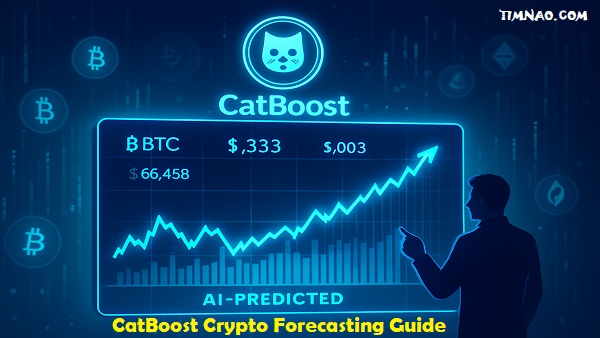Revolutionizing Crypto Forecasts: How AI and CatBoost Unlock Smart Market Predictions 🚀
CatBoost crypto forecasting is quickly becoming one of the most powerful tools for predicting cryptocurrency market movements—without requiring advanced coding skills or deep financial expertise. In an industry where price swings are fierce and emotions run high, using data-driven methods to anticipate trends can give you a serious edge.
But here’s the truth: most beginners shy away from AI because they think it’s too complex, too technical, or too expensive. The good news? Tools like CatBoost have changed the game, making professional-level crypto forecasting accessible to anyone—yes, even if you’re just starting out.
In this beginner-friendly guide, we’ll break down how CatBoost works, why it’s ideal for crypto data, and how you can start building your own forecasting models. You’ll learn not just the “how,” but also the “why”—empowering you to make smarter, more confident decisions in the fast-moving world of crypto.
Whether you’re a trader, an investor, or a curious explorer of the AI-meets-crypto frontier, this comprehensive article will give you the tools, the mindset, and the motivation to level up your strategy.
Let’s get started.
📚 Table of Contents
- 🚀 Introduction to AI-Powered Crypto Forecasting
- 🔍 What is CatBoost and Why It Matters
- 🤖 The FinTech Revolution Behind Crypto Predictions
- 🧠 How CatBoost Handles Complex Crypto Data
- 🛠️ Building a Forecasting Model: A Step-by-Step Guide
- 🧬 Feature Engineering for Stronger Predictions
- 🧪 Evaluating and Optimizing Your Crypto Model
- 🌍 Real-World Use Cases and Success Stories
- 🧭 What’s Next: Future Trends in Crypto Forecasting
- ✅ Final Thoughts for Beginners
🚀 Introduction to AI-Powered Crypto Forecasting
Cryptocurrency markets are fast-moving, volatile, and notoriously difficult to predict. But thanks to AI-driven technologies, particularly CatBoost models, there’s a new way to bring clarity to this chaos.
If you’ve ever wished for a smarter, more data-informed approach to understanding crypto trends, this guide is for you. We’ll walk you through the transformative power of AI in crypto forecasting, highlight the strengths of the CatBoost algorithm, and give you the tools to start predicting market movements—even if you’re a complete beginner.
In a world where digital currencies fluctuate by the minute, having access to intelligent prediction models can be the edge that sets you apart—whether you’re a trader, investor, or FinTech enthusiast.
🔍 What is CatBoost and Why It Matters
CatBoost, short for Categorical Boosting, is a machine learning algorithm developed by Yandex, designed especially for working with datasets that include categorical variables—think names of coins, exchanges, user behavior labels, or transaction types.
What makes CatBoost different from other machine learning algorithms like XGBoost or LightGBM?
- ✅ It natively supports categorical data, meaning you don’t need to convert everything into numbers before training your model.
- ✅ It prevents overfitting using a technique called ordered boosting, which is particularly helpful in noisy, unpredictable environments like crypto.
- ✅ It’s beginner-friendly, often delivering high accuracy right out of the box without deep parameter tuning.
In crypto markets, where variables are diverse and behavior-driven, CatBoost helps unlock high-accuracy predictions without overwhelming users with complexity.
Key Benefits of Using CatBoost in Crypto Forecasting:
| Feature | Why It Matters |
|---|---|
| 🔢 Handles categorical data natively | No need for complex preprocessing |
| 🔄 Ordered boosting | Reduces overfitting and boosts model stability |
| ⚡ Efficient with defaults | Great for beginners or fast prototyping |
| 🔍 High accuracy | Especially in mixed data environments like crypto |
With CatBoost, you’re not just building a prediction model—you’re building a smarter, more interpretable system that can grow with your crypto journey.
🤖 The FinTech Revolution Behind Crypto Predictions
To understand how AI and CatBoost became such game-changers in the crypto world, we need to zoom out and look at the broader FinTech evolution.
💡 FinTech: The New Backbone of Digital Finance
FinTech (Financial Technology) is more than just online payments. It’s a global movement integrating technologies like:
- Blockchain – making transactions secure and transparent.
- Artificial Intelligence (AI) – enabling smart decision-making.
- Internet of Things (IoT) – bringing real-time data from connected devices.
- Machine Learning – learning from past data to predict the future.
These technologies are transforming how we save, invest, trade, and forecast.
📈 Why Crypto Forecasting is FinTech’s New Frontier
Crypto, by nature, is digital, decentralized, and data-rich. That’s why FinTech innovation is surging in this space. AI tools can:
- Monitor blockchain transactions in real time
- Spot emerging trends through pattern recognition
- Evaluate coin performance, investor sentiment, and geopolitical risks
CatBoost becomes essential here because it can ingest complex, mixed-format data and still provide fast, high-accuracy forecasts.
🧠 How CatBoost Handles Complex Crypto Data
Most crypto datasets include a mix of:
- Numerical values (like prices, volumes)
- Categorical data (coin names, exchange platforms, wallet IDs)
- Textual or time-based inputs (news headlines, tweets, timestamps)
This is where CatBoost shines.
🔁 Native Handling of Categorical Features
Unlike most models, which require converting categories to dummy variables (aka one-hot encoding), CatBoost learns directly from the raw categories. This:
- Saves time in data prep
- Preserves natural relationships in the data
- Improves model performance and interpretability
🔄 Ordered Boosting to Avoid Overfitting
In volatile markets like crypto, models often overfit—meaning they perform great on past data but fail on new data.
CatBoost introduces ordered boosting, which processes data in a randomized order during training to prevent the model from “cheating” by memorizing outcomes. This makes predictions more reliable in real-world scenarios.
📊 Case Study Snapshot: Real-World Application of CatBoost
Projects like AlphaPy use CatBoost to power automated crypto trading systems. Why?
- 🧠 Better decision-making under uncertainty
- ⏱️ Faster processing of large, mixed datasets
- 🔍 High precision in identifying profitable trades
Similarly, tools like mljar-supervised use CatBoost to automatically detect and optimize features in financial forecasting tasks—giving even non-coders access to advanced AI.
🛠️ Building a Forecasting Model: A Step-by-Step Guide
So, you’re ready to build your first crypto forecasting model using CatBoost? Great! Whether you’re new to machine learning or just crypto curious, this part will walk you through each step—from raw data to real insights. No PhD required.
Let’s dive into the simplified yet powerful workflow.
1. 🗃️ Collect and Understand Your Data
Crypto markets generate a goldmine of data, but not all of it is useful. To forecast price trends, consider gathering:
- Price history (open, high, low, close, volume)
- On-chain metrics (transaction counts, active addresses, gas fees)
- Sentiment indicators (tweets, Reddit posts, news headlines)
- Technical indicators (moving averages, RSI, MACD)
- Macroeconomic data (interest rates, inflation, geopolitical news)
💡 Use APIs from CoinGecko, CryptoCompare, or even Glassnode for blockchain metrics.
2. 🧼 Clean and Prepare the Data
Raw crypto data can be noisy. Cleaning is essential to build a model that doesn’t get confused.
Key tasks:
- Remove duplicates and outliers
- Fill in missing values (CatBoost handles this well, but it’s still best practice to review)
- Convert timestamps to meaningful formats (e.g., “day of the week,” “hour of day”)
- Format categorical variables like coin names, trading pairs, or exchanges properly
Bonus: CatBoost handles missing values and categorical variables natively, so you can skip complex encoding and imputation steps required in other ML models.
3. 🧬 Feature Engineering: Turning Raw Data into Gold
Here’s where magic happens. Features are the predictors your model uses to understand patterns.
Examples of effective crypto forecasting features:
| Feature Type | Example Variables |
|---|---|
| Price-based | 7-day moving average, Bollinger Bands, volatility |
| Volume-based | 24h volume change, volume-to-market-cap ratio |
| Time-based | Day of week, hour, market open/close patterns |
| Sentiment-related | Tweet volume, news tone score, Reddit post frequency |
| On-chain analytics | Wallet activity, miner flows, token velocity |
Keep it relevant. Use domain logic to decide which variables actually impact crypto price behavior.
4. 🔧 Choose Your Target Variable
What are you predicting?
- 📈 Price movement direction (up/down → classification task)
- 💰 Future price or return (numeric → regression task)
- ⚠️ Volatility or risk exposure (probabilistic → advanced regression)
For beginners, start with binary classification:
Will Bitcoin’s price go up tomorrow? (Yes = 1, No = 0)
This makes evaluation and decision-making easier.
5. 🧠 Train Your CatBoost Model
Now that you’ve got features and targets, it’s training time!
Basic training code example (Python):
from catboost import CatBoostClassifier
model = CatBoostClassifier(iterations=300, learning_rate=0.1, depth=6, verbose=100)
model.fit(X_train, y_train, cat_features=categorical_columns)
Even without parameter tuning, CatBoost often gives great performance. That’s the beauty of it.
If you’re building in a no-code or AutoML platform like mljar, CatBoost is often an included backend option.
6. 📊 Evaluate Your Model’s Accuracy
It’s not enough for your model to make predictions—you need to trust those predictions.
Key metrics to watch:
- ✅ Accuracy – Basic score of correct predictions
- 🔄 Precision & Recall – How well it catches real signals
- 📉 ROC-AUC – Balances true positives vs. false positives
- 🧠 Confusion Matrix – Helps visualize right vs. wrong predictions
For regression tasks (predicting prices), use:
- 🧮 Mean Absolute Error (MAE)
- 📈 Root Mean Squared Error (RMSE)
💡 Don’t get obsessed with “perfect” accuracy. Crypto is chaotic. A model that performs slightly better than random is already valuable.
7. 🪄 Fine-Tune Your Model with Hyperparameters
CatBoost offers plenty of tuning options like:
| Parameter | Description | Tip |
|---|---|---|
learning_rate |
Controls how fast the model learns | Start with 0.1 |
depth |
Depth of decision trees | Try 6–10 |
iterations |
Number of boosting rounds | More isn’t always better |
l2_leaf_reg |
Regularization to avoid overfitting | Use 3–5 for starters |
loss_function |
Choose ‘Logloss’ for classification | ‘RMSE’ for regression |
Use grid search or tools like Optuna for automated tuning if needed.
8. 🚀 Deploy and Monitor Your Model
Once the model looks solid, deploy it for real-time or periodic predictions.
Options:
- 🛠️ Host it with FastAPI + Docker
- 📈 Integrate with your trading bot or dashboard
- ⏱️ Schedule periodic forecasts (e.g., every hour or daily)
And don’t forget to monitor performance over time. Market conditions change, and models may need retraining regularly.
⚠️ Common Mistakes to Avoid
- ❌ Using future data accidentally (data leakage)
- ❌ Overfitting with too many features
- ❌ Ignoring feature importance or interpretability
- ❌ Blindly trusting the model without real-world validation
Building forecasting models is part art, part science—and lots of testing.
🧬 Feature Engineering for Stronger Predictions
In machine learning—especially in crypto forecasting—the model is only as good as the features you feed it. This process, called feature engineering, is where you transform raw data into smart, predictive signals.
For beginners, this is both an art and a science. The right features can dramatically boost your CatBoost model’s accuracy—even more than tuning parameters.
Let’s break it down.
🔍 What is Feature Engineering?
Feature engineering is the process of selecting, creating, and transforming data points (features) that help your model recognize patterns and make better predictions.
In crypto forecasting, features could include everything from price momentum and social media activity to network health and market sentiment.
Think of it as building a custom toolbox for your AI model to analyze and interpret the crypto market.
⚙️ Categories of Useful Features in Crypto Prediction
Let’s explore the main types of features used in high-performing crypto models.
1. 📊 Price-Based Features
These features derive directly from historical price action.
- Moving Averages (MA): e.g., 7-day, 14-day, 50-day
- Price Momentum: difference between closing prices
- Volatility Index: standard deviation over a time window
- Rate of Change (ROC): speed of price movement
- Technical Indicators: RSI, MACD, Bollinger Bands
CatBoost performs well even when your features have non-linear relationships, so these technical indicators can be gold.
2. 🧾 Volume & Liquidity Features
- Trading Volume Change: percentage increase/decrease
- Volume-to-Market Cap Ratio: liquidity insights
- Order Book Depth: bid/ask strength from exchange APIs
- Exchange Flow: inflows and outflows to exchanges
These features often indicate buy/sell pressure, useful for short-term predictions.
3. 🧠 Sentiment and Social Signals
Yes, even tweets and Reddit threads can move markets. You can convert these into quantifiable features.
- Tweet frequency or engagement on crypto topics
- Sentiment score from NLP models (positive/neutral/negative)
- Google Trends popularity
- Telegram group chatter volume
📌 Tools like Hugging Face Transformers or TextBlob can help you analyze sentiment programmatically.
4. 🔗 On-Chain Analytics
Pull from blockchain explorers or analytics platforms like Glassnode.
Key features include:
- Active addresses (daily/weekly)
- New wallet creation
- Large wallet movements (whale alerts)
- Mining difficulty
- Staking flows
These provide real insights into network health and behavior—important context that most traders ignore.
5. ⏱️ Temporal Features
- Day of the week: e.g., weekend volatility spikes
- Time of day: e.g., Asia/US market open effects
- Holiday flags: volatility often drops on public holidays
Temporal features help uncover cyclical patterns in the crypto market.
💡 Pro Tip: Use Feature Combinations
Combine simple features into composite signals for better forecasting.
Examples:
- 📉 RSI + Moving Average = Trend strength + overbought/oversold
- 💬 Twitter Sentiment + Whale Transactions = Emotion + market force
- 🧮 On-chain + Exchange Volume = Network activity + liquidity
CatBoost can handle complex interactions automatically. So even if you aren’t sure how strong the combination is, test it—you might uncover hidden alpha.
📈 Feature Transformation Techniques
Sometimes, you’ll want to transform raw features to reveal better signals.
Common techniques:
| Transformation | Example | Use |
|---|---|---|
| Log scaling | log(price) |
For skewed data like volume or market cap |
| Z-score normalization | (x - mean) / std |
Useful for volatility-based features |
| Binning | Group RSI into categories (e.g., low, neutral, high) | Makes it easier to interpret behavior |
| Lag features | Add features like “Price 3 days ago” | Capture past influence on future movement |
CatBoost works well with raw and transformed data, but using both can sometimes improve results.
🧪 Feature Selection: Keep Only What Works
Not all features are helpful. In fact, too many features can confuse your model and slow down training.
Here’s how to clean your feature set:
- ✅ Use CatBoost’s built-in feature importance tool:
model.get_feature_importance(prettified=True) - 🚫 Drop features with near-zero importance or correlation
- 📊 Use correlation heatmaps to detect and remove redundant features
- 🧪 Test features incrementally to see impact on your accuracy or AUC score
🤖 Use Automated Feature Engineering (Optional)
If you want to go deeper, tools like:
- FeatureTools
- AutoFeat
- AutoML libraries (e.g., mljar-supervised)
can help generate hundreds of features automatically, then test and filter the best ones.
These tools save time—especially for beginners not yet comfortable coding in pandas or NumPy.
🔍 Real-Life Example: Feature Engineering for BTC Forecasting
Let’s say you want to predict Bitcoin’s price trend for the next day.
Here’s a sample of engineered features:
| Feature | Description |
|---|---|
btc_7d_ma |
7-day moving average of closing price |
btc_volatility |
Standard deviation over past 14 days |
rsi_score |
Relative Strength Index from TA-lib |
twitter_sentiment_score |
NLP-derived score from Bitcoin tweets |
wallet_inflow_ratio |
% increase in exchange-bound wallets |
weekend_flag |
1 if Saturday/Sunday, 0 otherwise |
Plug these into CatBoost, and you’ve got a smart forecasting model without needing deep math or finance experience.
⚠️ Common Pitfalls to Avoid
- ❌ Creating features using future data (leakage!)
- ❌ Using highly correlated features that confuse the model
- ❌ Over-engineering without evaluating effectiveness
- ❌ Ignoring domain knowledge—crypto isn’t just numbers
Feature engineering isn’t about stuffing in more data—it’s about making smarter, more relevant data available to your model.
🧪 Evaluating and Optimizing Your Crypto Model
You’ve trained your CatBoost crypto forecasting model and it’s giving you predictions. But how do you know if it’s actually working? More importantly—how do you make it better?
Welcome to the crucial step of model evaluation and optimization. This is where beginners often stumble, but with the right mindset and metrics, you can confidently turn raw results into reliable insights.
Let’s explore how to measure, improve, and trust your CatBoost-powered predictions.
🧭 Why Evaluation Matters in Crypto Forecasting
Crypto markets are notoriously volatile, and even the best model won’t get every prediction right. That’s why evaluation is about measuring how useful the model is, not just how accurate.
Unlike stock markets, crypto is 24/7, community-driven, and highly sensitive to:
- Sudden news (like exchange hacks)
- Market sentiment shifts
- Unexpected whale movements
You don’t need perfect predictions. You need reliable signals that work consistently over time.
📏 Key Metrics to Measure Model Performance
The metrics you choose will depend on your prediction goal (classification or regression). Let’s look at both.
🔀 For Classification Models
Use when predicting things like “Will BTC go up tomorrow?”
| Metric | What It Measures | When to Use |
|---|---|---|
| Accuracy | Overall % of correct predictions | Balanced classes |
| Precision | % of predicted positives that were correct | Avoiding false alarms |
| Recall | % of actual positives correctly predicted | Catching all upward trends |
| F1 Score | Balance between precision and recall | When both false positives/negatives matter |
| ROC-AUC | Model’s ability to rank positives higher | Overall classifier performance |
| Confusion Matrix | Visual map of predictions vs actuals | Diagnosis of errors |
📌 Example: If your model predicts BTC price will go up, but only gets it right 60% of the time, that might still be better than guessing—especially when combined with a good risk management strategy.
📉 For Regression Models
Use when predicting a continuous value like “What will ETH price be tomorrow?”
| Metric | What It Measures | When to Use |
|---|---|---|
| MAE (Mean Absolute Error) | Average absolute difference between actual & predicted values | Easy to interpret, less sensitive to outliers |
| RMSE (Root Mean Squared Error) | Emphasizes larger errors more heavily | Penalizes large mistakes more |
| MAPE (Mean Absolute Percentage Error) | Percentage error vs actual price | Useful for financial forecasting |
| R² Score | How much variance your model explains | For model comparison and tuning |
⚙️ How to Evaluate CatBoost Models in Practice
Here’s a simple evaluation setup using Python:
For classification:
from sklearn.metrics import accuracy_score, f1_score, confusion_matrix
y_pred = model.predict(X_test)
print("Accuracy:", accuracy_score(y_test, y_pred))
print("F1 Score:", f1_score(y_test, y_pred))
print("Confusion Matrix:\n", confusion_matrix(y_test, y_pred))
For regression:
from sklearn.metrics import mean_absolute_error, mean_squared_error, r2_score
y_pred = model.predict(X_test)
print("MAE:", mean_absolute_error(y_test, y_pred))
print("RMSE:", mean_squared_error(y_test, y_pred, squared=False))
print("R² Score:", r2_score(y_test, y_pred))
🧠 CatBoost also includes visualization tools for deeper evaluation:
from catboost import Pool, cv
cv_data = cv(Pool(X_train, y_train), model.get_params(), fold_count=5)
🧠 Interpreting Feature Importance
Understanding why your model makes decisions is just as important as accuracy.
CatBoost gives you tools to visualize feature importance:
model.get_feature_importance(prettified=True)
This shows which features (like RSI, volume_change, or twitter_sentiment) were most helpful in making predictions.
You can also visualize this:
import matplotlib.pyplot as plt
import seaborn as sns
feature_importances = model.get_feature_importance()
sns.barplot(x=feature_importances, y=feature_names)
plt.title("Feature Importance")
plt.show()
Use this insight to refine your features—keep the most important, drop the noisy ones.
🔍 Practical Optimization Strategies
Let’s now move to the improvement phase: tuning your CatBoost model.
🎛️ Hyperparameter Tuning Basics
Here are the most common parameters to tweak:
| Parameter | Description | Suggested Range |
|---|---|---|
learning_rate |
Controls how fast the model learns | 0.01 to 0.2 |
depth |
Depth of decision trees | 4 to 10 |
iterations |
Number of boosting rounds | 100 to 1000+ |
l2_leaf_reg |
Regularization strength | 1 to 10 |
bagging_temperature |
Controls randomness in data sampling | 0 to 1 |
CatBoost works well with default values, but tuning gives better results for production models.
🔁 Grid Search (for Beginners)
This brute-force method tries every combination of settings to find the best one.
from sklearn.model_selection import GridSearchCV
from catboost import CatBoostClassifier
params = {
'depth': [4, 6, 8],
'learning_rate': [0.01, 0.1],
'iterations': [200, 500]
}
grid = GridSearchCV(CatBoostClassifier(verbose=False), params, cv=3)
grid.fit(X_train, y_train)
print(grid.best_params_)
🧬 Use Optuna for Auto Tuning (Advanced)
Optuna is a hyperparameter optimization library that’s faster and smarter than grid search.
It automates tuning and works seamlessly with CatBoost:
import optuna
def objective(trial):
params = {
'depth': trial.suggest_int('depth', 4, 10),
'learning_rate': trial.suggest_loguniform('learning_rate', 0.01, 0.2),
'iterations': trial.suggest_int('iterations', 100, 1000)
}
model = CatBoostClassifier(**params, verbose=0)
model.fit(X_train, y_train)
preds = model.predict(X_test)
return f1_score(y_test, preds)
study = optuna.create_study(direction="maximize")
study.optimize(objective, n_trials=30)
🚧 Avoid These Common Evaluation Mistakes
- ❌ Evaluating on training data instead of unseen test data
- ❌ Ignoring class imbalance (use stratified split or class weights)
- ❌ Overfitting to validation data by tuning too much
- ❌ Misinterpreting accuracy when classes are unbalanced
Always use a separate test set or cross-validation to ensure your model generalizes well.
🔄 Retraining and Continuous Evaluation
Crypto markets change fast. That means your model might degrade over time.
Tips for staying sharp:
- ⏱️ Retrain your model weekly or monthly
- 🧪 Use rolling windows for time-based validation
- 📊 Monitor accuracy or returns over time
- ⚠️ Set alerts for performance drops
This turns your model from a one-time experiment into a living, evolving strategy.
🌍 Real-World Use Cases and Success Stories
Knowing how to build a CatBoost crypto forecasting model is one thing—seeing it work in the real world is another. This section dives into actual examples of AI-powered crypto forecasting in action and how individuals and companies are using CatBoost to gain an edge in the market.
If you’re a beginner, this is where theory becomes inspiring reality.
🧠 Institutional Use: AI-Driven Hedge Funds
Several forward-thinking hedge funds and quant trading firms have adopted CatBoost and similar machine learning tools to forecast market moves and manage risk.
🏦 Example: ML-Powered Crypto Portfolios
Some hedge funds now run multi-factor models trained with CatBoost to:
- Predict short-term price trends
- Allocate capital between volatile coins like BTC, ETH, and altcoins
- Hedge positions using volatility forecasts
- Detect “pump-and-dump” patterns before they happen
These models often rely on:
- Historical price features
- Market sentiment (from news and social media)
- On-chain activity
- Macro indicators like U.S. Fed announcements or global events
📌 While the details are often proprietary, job listings and publications from firms like Numerai, Two Sigma, and Jane Street confirm that gradient boosting models—including CatBoost—are in regular use.
👨💻 Individual Traders Using CatBoost
You don’t need a hedge fund budget to benefit from AI. Even solo traders are now using CatBoost in personal forecasting projects.
🧪 Example: DIY Crypto Forecasting Bot
A solo developer built a personal bot using Python, the CatBoost library, and APIs from CoinGecko and Binance to:
- Pull hourly data for BTC and ETH
- Train a model daily on short-term trends
- Forecast “price up or down in the next hour”
- Send buy/sell alerts to Telegram
Over time, by including sentiment features (Reddit comment frequency + Twitter sentiment), the model’s F1 score improved from 0.52 to 0.66—a meaningful jump.
The best part? This was done on a regular laptop using just open-source tools.
🧰 Startups Embedding CatBoost in Their Platforms
Crypto-focused startups and data platforms are also integrating CatBoost behind the scenes to offer smarter insights.
🚀 Example: Crypto Trading Platforms with Smart Alerts
Some trading platforms now offer features like:
- “AI-based price prediction”
- “Volatility warnings”
- “Forecast-based trade suggestions”
These features are often powered by lightweight ML models like CatBoost or LightGBM because they’re fast, easy to maintain, and offer explainable results.
Startups such as:
- mljar.com (AutoML platform that supports CatBoost)
- Tradytics (AI for options and crypto traders)
- Token Metrics (crypto research platform using AI signals)
… use similar ML stacks to deliver forecasting models to non-technical users via dashboards and APIs.
📊 Academic Research with CatBoost in Crypto
The research community has also embraced CatBoost for crypto forecasting due to its transparency and effectiveness.
📚 Example: University Projects & Published Papers
In multiple peer-reviewed studies and capstone projects, CatBoost has been benchmarked against:
- Logistic regression
- Random forest
- XGBoost
- LSTM neural networks
And surprisingly, CatBoost often outperforms deep learning models when datasets are small-to-medium and contain a mix of categorical + numeric data (as is typical in crypto markets).
One such study found that a CatBoost model trained on:
- Technical indicators (MACD, RSI)
- Reddit keyword frequency
- Wallet transaction stats
…could forecast ETH’s hourly price direction with an accuracy of 70%, while being faster and more interpretable than complex neural nets.
🛡️ Risk Management with Predictive Models
Another real-world use case is crypto risk modeling.
CatBoost is used to:
- Predict volatility spikes based on whale wallet activity
- Trigger automatic de-risking of portfolios when certain thresholds are met
- Provide probabilistic estimates for risk vs. reward on upcoming trades
Institutions use this in derivatives markets, while retail investors can apply the same principles to manage exposure to high-risk coins.
💡 Bonus: NFT and GameFi Trend Prediction
In the broader Web3 space, forecasting isn’t limited to coins. Teams are using CatBoost to:
- Forecast NFT project floor prices
- Predict user retention in GameFi platforms
- Detect fraud or rug-pulls early using wallet behavior + social chatter
CatBoost is perfect for this because these environments include lots of categorical metadata (wallet addresses, contract IDs, project categories), which CatBoost handles better than most ML models.
🚀 Lessons from the Field
Across all these use cases, one truth stands out:
CatBoost shines in environments with mixed data, limited labels, and a need for fast, interpretable forecasts—which describes the crypto world perfectly.
Real-world users, from academic teams to solo developers to FinTech startups, continue to choose CatBoost because it offers the right balance of simplicity, speed, and performance.
If you’re just getting started in AI-powered crypto prediction, this is the most beginner-friendly path that can still scale to powerful, production-grade systems.
🧭 What’s Next: Future Trends in Crypto Forecasting
As the world of cryptocurrencies evolves, so too does the technology used to predict its movement. The tools and techniques we use today—like CatBoost—are just the beginning of a larger transformation driven by AI, big data, and decentralized intelligence.
In this section, we’ll explore the most promising future trends shaping crypto forecasting, and what beginners need to watch if they want to stay ahead of the curve.
🌐 1. Decentralized AI Forecasting Models
One of the biggest developments on the horizon is the rise of decentralized AI—predictive models that run not on centralized servers, but across blockchain-powered ecosystems.
These systems allow users to:
- Contribute data anonymously
- Collaborate on model training
- Earn tokens for valuable predictions
🔮 Example: Numerai
Numerai is a hedge fund that lets data scientists around the world contribute predictions through encrypted data. Their models compete in weekly tournaments, and the best ones get rewarded with cryptocurrency.
This concept could expand into:
- Open-source prediction markets
- DAO-managed AI forecasting platforms
- AI-powered DeFi strategy engines
As more people demand privacy-first, community-led solutions, expect decentralized forecasting to grow—especially for crypto-native assets.
🧠 2. Deep Learning + CatBoost Hybrids
While CatBoost is strong on its own, some advanced users are beginning to combine it with deep learning models like LSTMs and Transformers to capture both short-term patterns and long-term trends.
Why hybrid models?
- LSTM excels at capturing time-series dependencies
- CatBoost is great at feature richness and decision logic
- Together, they provide more complete insights
📌 Example Use Case:
A hybrid model might use an LSTM to process historical price sequences and then feed the output into a CatBoost model along with other features like:
- Twitter sentiment
- On-chain wallet activity
- Exchange liquidity
This kind of stacked model approach can improve forecast accuracy while preserving interpretability.
📡 3. Real-Time, Low-Latency Forecasting
The crypto market never sleeps. That’s why the next generation of tools is focusing on real-time forecasting, with models that:
- Continuously train on streaming data
- Trigger alerts in milliseconds
- Adapt dynamically to market volatility
To do this, developers are integrating:
- Kafka for streaming data pipelines
- FastAPI or Flask for low-latency endpoints
- GPU acceleration for faster model inference
💡 While this setup sounds advanced, tools like Hugging Face, ONNX, and NVIDIA RAPIDS are making real-time AI more accessible—even for solo developers.
🧬 4. AI-Generated Features & Synthetic Data
Traditionally, feature engineering was manual. But now, AI is being used to generate synthetic features and even synthetic datasets when real data is scarce.
Tools like:
- Featuretools
- AutoFeat
- DataSynthesizer
- Gretel AI
…are helping users enrich their models with new, meaningful signals—automatically.
In crypto, this is huge. For low-volume coins or niche projects, where data is limited, these tools can fill the gaps and expand your model’s intelligence without risking overfitting.
🧠 5. Explainable AI (XAI) for Forecasting
As models get smarter, users demand more transparency. Enter Explainable AI (XAI)—tools and techniques that reveal how AI makes decisions.
With CatBoost, you already get:
- Built-in feature importance
- SHAP value support for deeper analysis
But the future includes:
- Interactive dashboards showing which inputs mattered most
- Trust scores to show confidence in each prediction
- Visual timelines for how sentiment or wallet flows influence price
This transparency builds user trust—and is especially important when AI is used to automate high-value trades.
💬 6. Multimodal AI: Merging Text, Charts & Data
The next frontier is multimodal AI—models that can simultaneously analyze:
- Text (e.g., tweets, news)
- Charts (e.g., candlestick patterns)
- Structured data (e.g., volumes, indicators)
Imagine a single forecasting system that:
- Reads headlines from CoinDesk
- Analyzes BTC price patterns visually
- Weighs social media emotion
- Pulls in economic news or regulation alerts
This kind of model could offer hyper-contextual, high-accuracy predictions.
Companies like OpenAI, Google DeepMind, and Meta AI are already working on such architectures—and they will surely shape future crypto tools.
🚀 7. AI-Augmented Trading Tools for Retail Investors
Not everyone wants to code or build models. That’s why the future is bright for AI-enhanced trading platforms that offer:
- Visual crypto dashboards
- Forecast-based alerts
- Auto-trading based on customizable logic
Examples:
- Token Metrics offers AI-graded coins
- 3Commas enables bot-based trading with signal inputs
- LunarCrush shows social sentiment for coins
Expect tools like these to integrate CatBoost-based engines in the background, enabling non-technical traders to leverage AI without writing a single line of code.
🧠 8. Predictive Governance in DAOs & DeFi
Crypto forecasting is also expanding beyond markets. In the future, DAOs (Decentralized Autonomous Organizations) may use predictive models to:
- Allocate treasury funds
- Predict protocol health
- Manage inflation and token supply
DeFi protocols can use forecasting for:
- Dynamic collateral management
- Flash loan risk scoring
- Smart oracle pricing
In these cases, CatBoost’s speed, transparency, and low compute cost make it a strong fit—even for models running on-chain or in lightweight web3 environments.
🔮 Final Forecast: AI Will Democratize Crypto Mastery
The future of crypto forecasting will not be limited to big firms or seasoned traders. Thanks to tools like CatBoost and the trends above, any motivated beginner can now:
- Build powerful models
- Make smarter trades
- Avoid hype traps
- Stay ahead of volatile swings
Whether you’re a coder, a trader, or a curious observer, the next wave of AI tools is coming to empower you—not replace you.
✅ Final Thoughts for Beginners
The world of cryptocurrency can feel overwhelming—prices change by the second, headlines come fast, and FOMO is real. But the good news? You don’t have to be a data scientist or Wall Street veteran to navigate crypto with confidence.
Thanks to accessible AI tools like CatBoost, anyone—even beginners—can start building forecasting models, analyzing trends, and making smarter trading decisions based on data, not just gut feelings.
🚀 Start Small, Learn Fast
If you’re new to all of this, here’s a simple roadmap to begin:
- Pick One Coin
Focus on a single asset (like BTC or ETH) so you don’t get overwhelmed. - Gather Basic Data
Use platforms like CoinGecko or CryptoCompare to collect price and volume data. - Install CatBoost
Set up Python and run:pip install catboost - Train a Simple Model
Start with a binary classification:Will the price go up or down tomorrow?
- Experiment and Learn
Try adding features like RSI, MACD, or tweet volume. See how accuracy changes. Play with parameters.
You’ll learn faster by doing, and tools like CatBoost make this hands-on process feel less intimidating.
🧠 Embrace Imperfection
Crypto is chaotic. Even the best models will be wrong—sometimes often. But that’s okay.
Forecasting is not about being right 100% of the time. It’s about improving your decision-making edge. A model that gets predictions right 60–70% of the time can already be life-changing when paired with solid risk management.
📈 The goal isn’t perfection—it’s progression.
🛠️ Use AI as a Decision Support System
Don’t think of AI as a magic box that tells you what to do.
Instead, use your CatBoost model to:
- Identify potential entry/exit signals
- Spot anomalies in coin behavior
- Filter out hype from genuine momentum
- Improve your conviction before acting
When you treat AI as a decision support system, not a replacement for thinking, you unlock its true power.
🔒 Prioritize Risk Management
No model, no matter how accurate, will save you from poor risk management.
Tips for beginners:
- Never risk more than 1–2% of your portfolio on a single trade
- Use stop-losses—even if AI says you’re right
- Diversify your bets and avoid leverage when testing new strategies
- Track your decisions and model performance weekly
AI can guide your strategy, but you’re still the pilot.
💬 Keep Learning and Iterating
The crypto space changes fast. So should your models.
Revisit your predictions. Ask:
- Did the model miss a key event?
- Was the data up-to-date?
- Could new features help?
- Is it time to retrain?
Every loss is a lesson. Every win is a pattern. Over time, you’ll get sharper—not just technically, but strategically.
🤝 Join the Community
You’re not alone. Join communities like:
- r/MachineLearning
- r/CryptoCurrency
- Kaggle (for real crypto forecasting competitions)
- GitHub (search “CatBoost crypto” to explore public projects)
Collaborate. Share your models. Learn from others. You’ll grow faster in the open-source, AI-curious ecosystem.
🧠 Final Takeaway
CatBoost isn’t just an algorithm—it’s a gateway to smarter crypto investing.
For beginners, it offers:
✅ Simple setup
✅ High performance
✅ Built-in support for messy crypto data
✅ Interpretability and control
And paired with the future of real-time AI, sentiment analysis, and DeFi prediction tools, it opens the door to a new generation of data-driven investors.
Whether you’re forecasting Bitcoin’s next move or analyzing token flows on the Ethereum network, the best time to start learning was yesterday.
The next best time? Right now.









